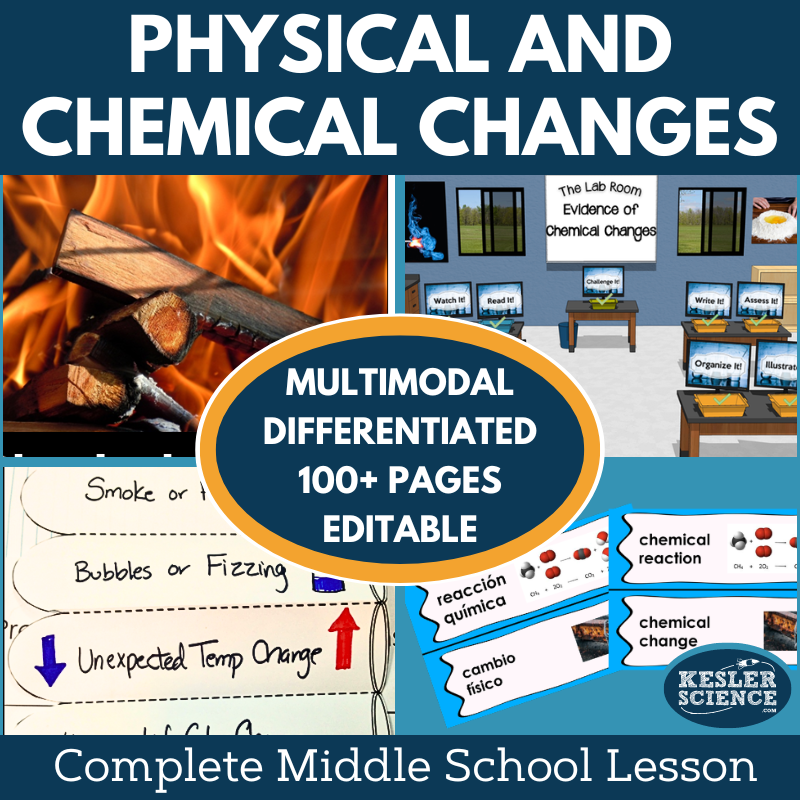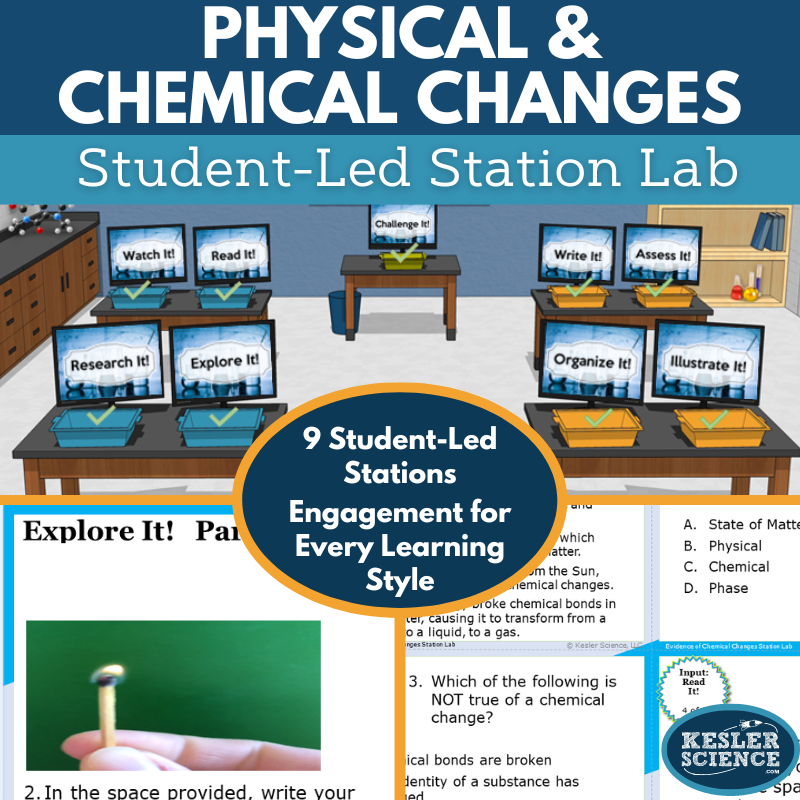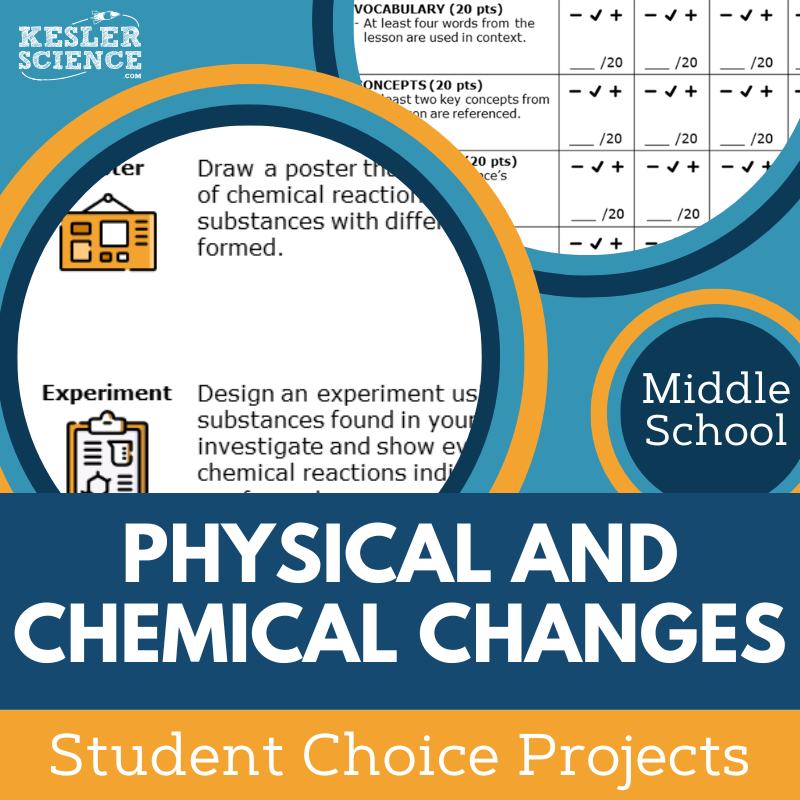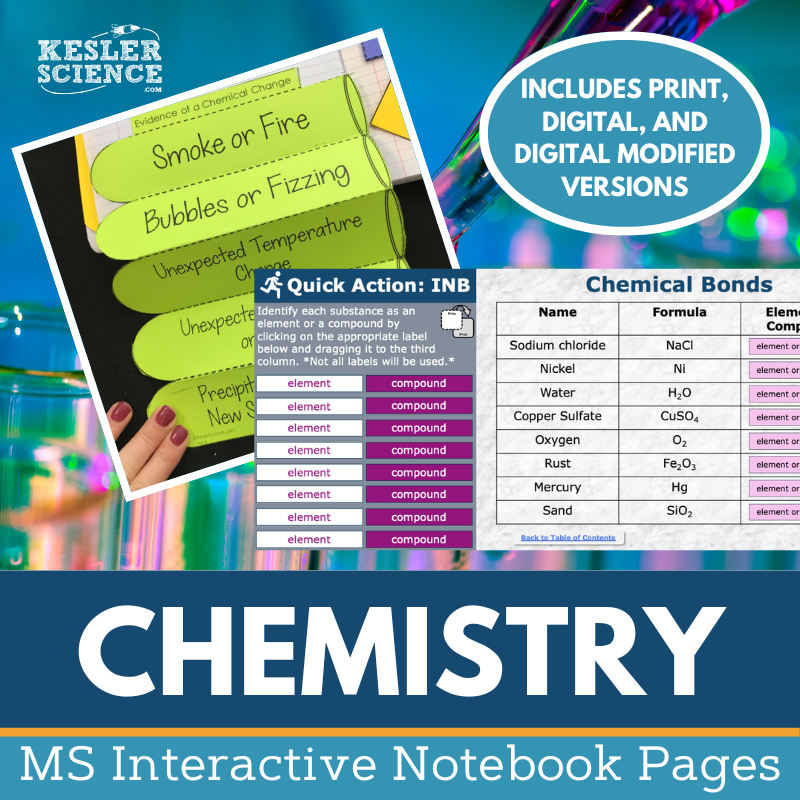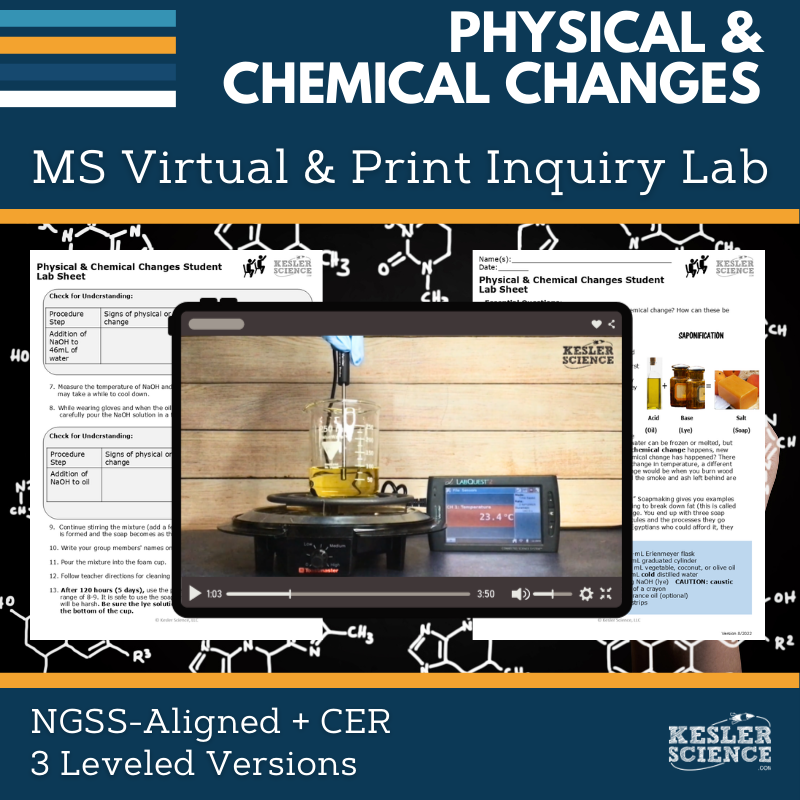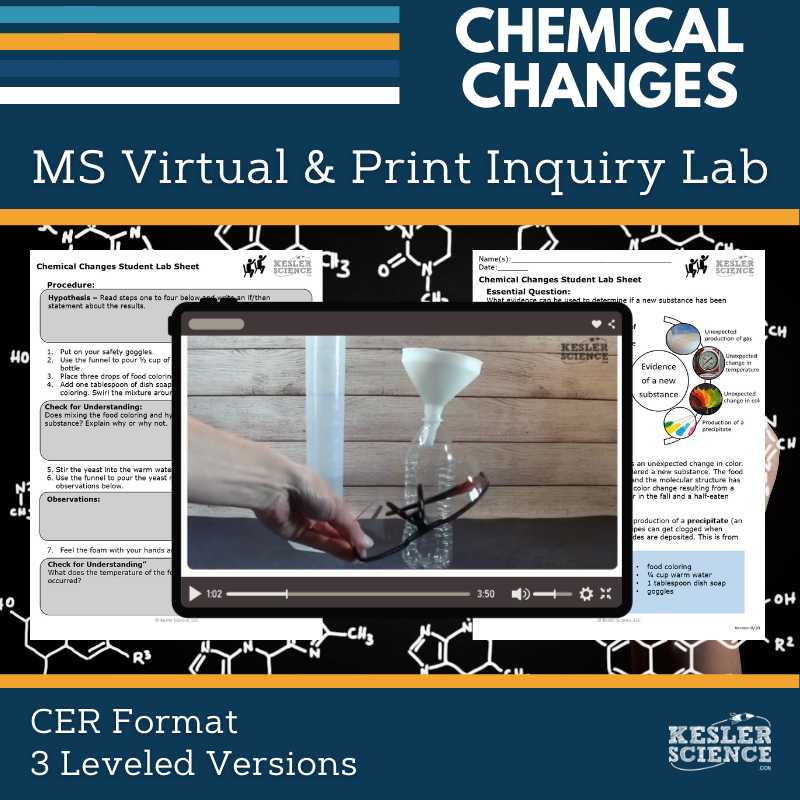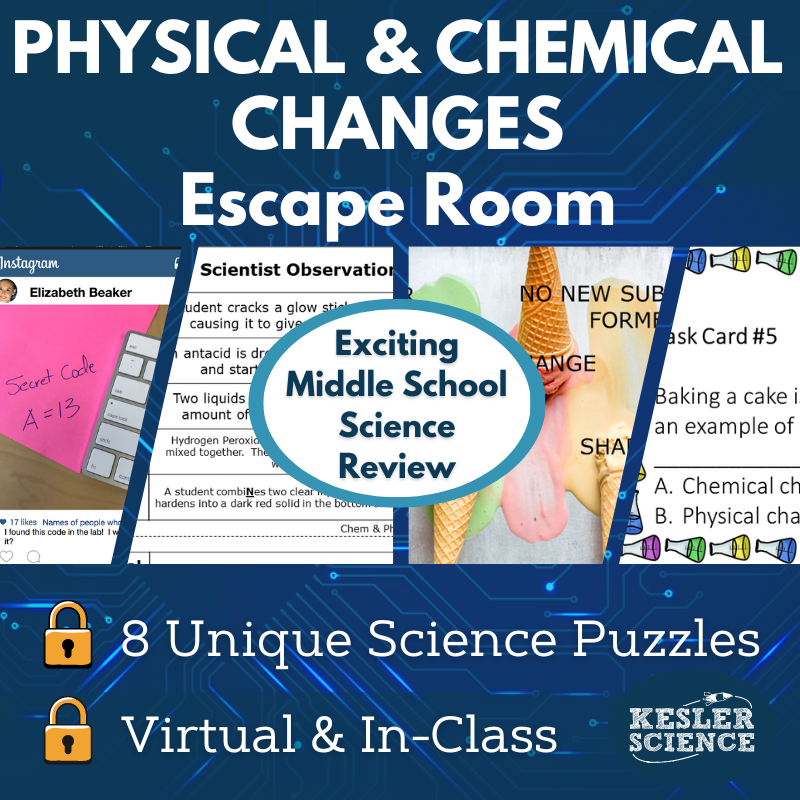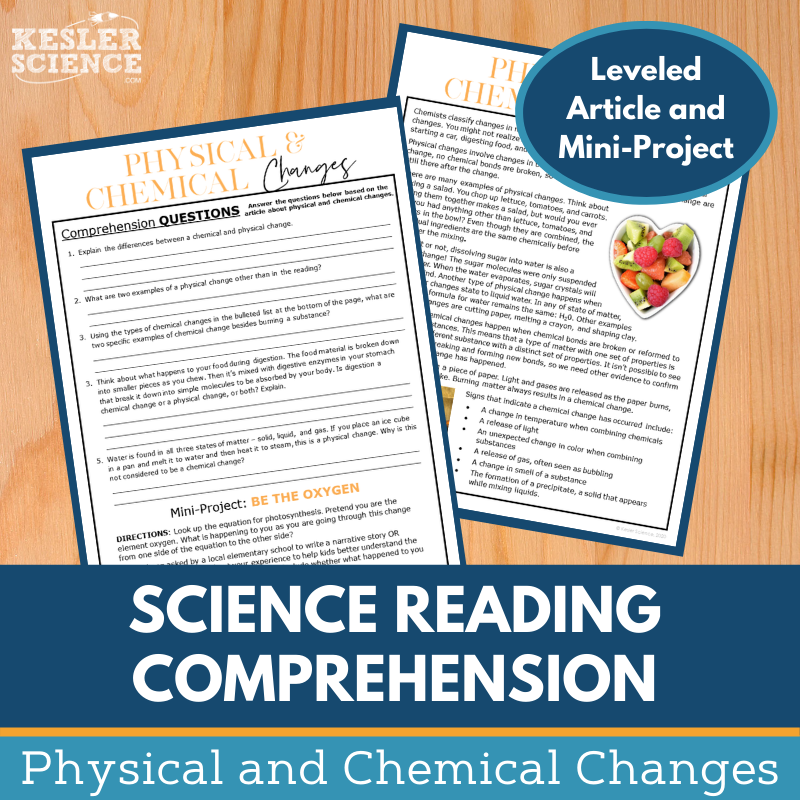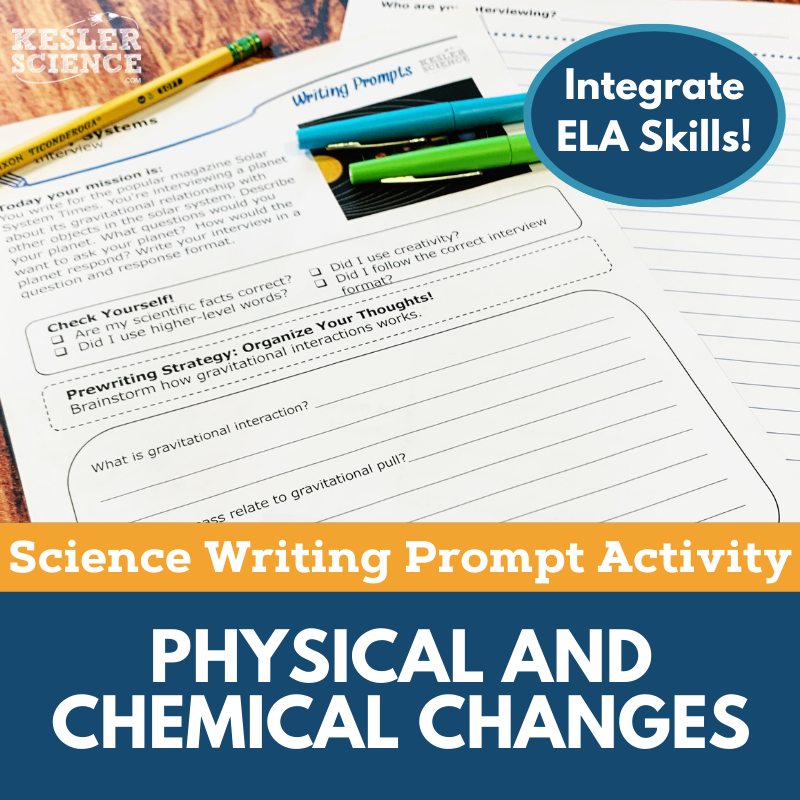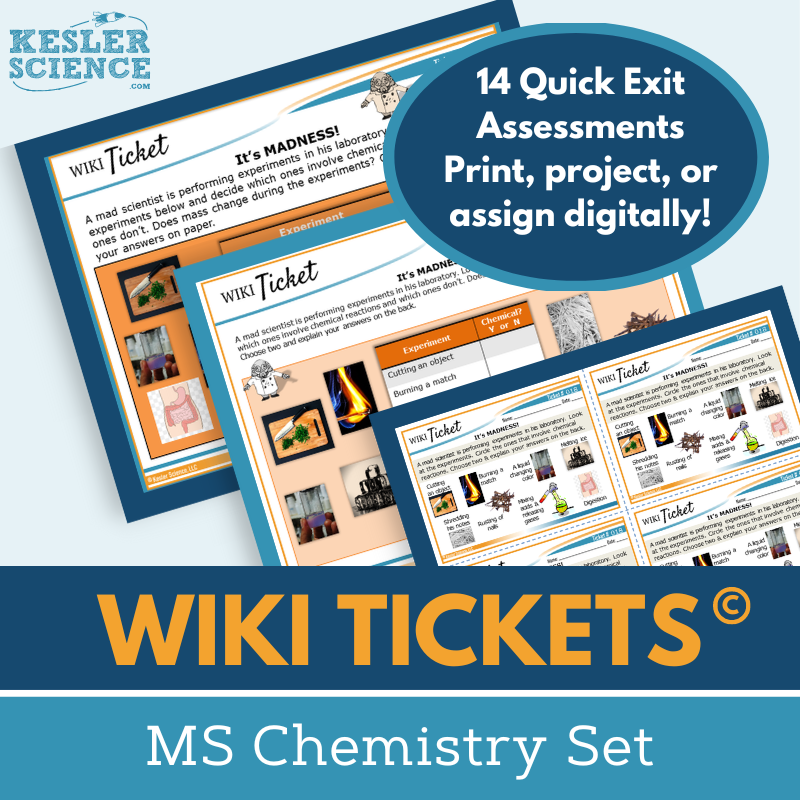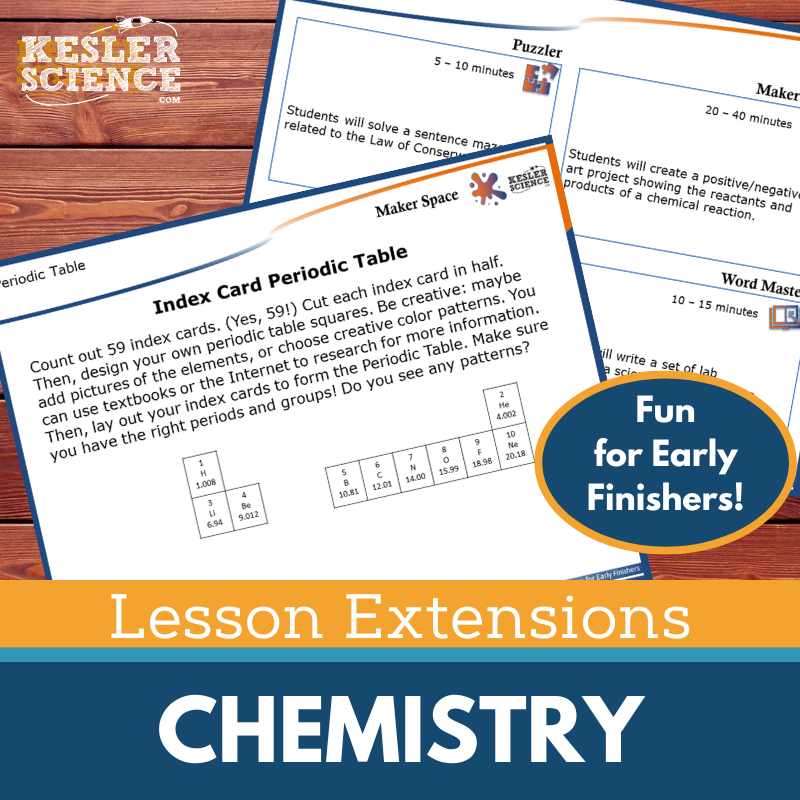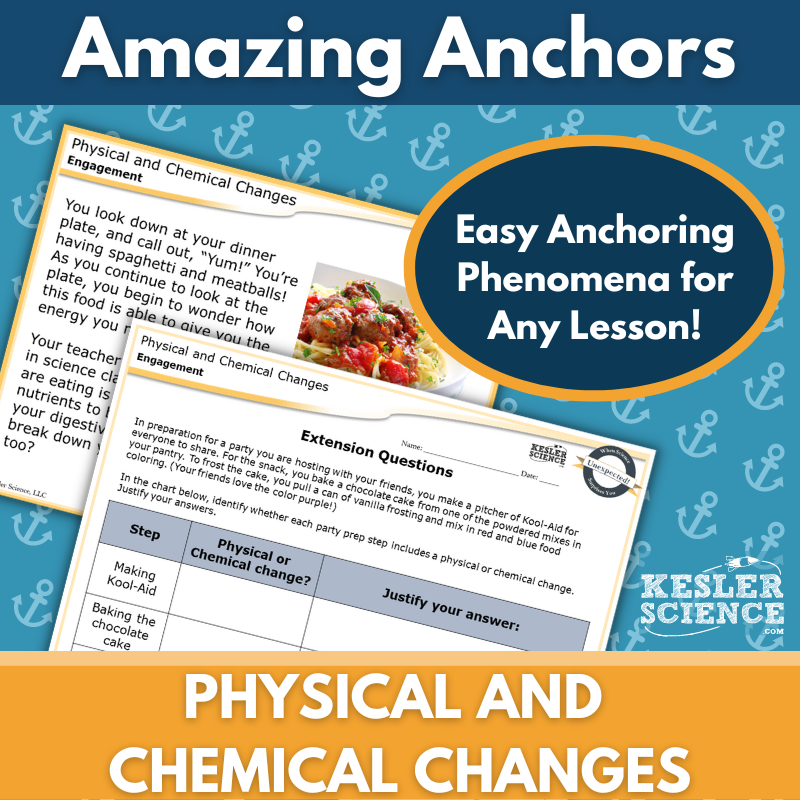Physical and Chemical Changes Activities for Middle School Science
The Kesler Science Physical and Chemical Changes resources provide comprehensive, engaging materials for teaching middle school students about chemical reactions and the formation of new substances. The resources below will give students a comprehensive understanding of physical and chemical changes. All of the following materials are also included in the Kesler Science Membership.
The Kesler Science Physical and Chemical Changes Complete 5E Lesson provides all the materials needed to teach an engaging, multi-day unit on physical and chemical changes. The lesson is student-led, allowing for minimal prep while focusing on real student success through differentiated activities and multimodal learning options. The lesson aligns with the 5E Model (Engagement, Exploration, Explanation, Elaboration, Evaluation) to support various learning styles.
The lesson includes input stations like hands-on experiments, reading passages in English and Spanish, and videos. Output stations allow students to demonstrate knowledge through activities such as card sorts, writing prompts, and illustrations. There’s also a bonus station for early finishers with extension activities to deepen understanding. Teachers can use both printable and digital formats, including editable PowerPoints and interactive notebook templates, making the lesson flexible for all classroom settings.
This resource is designed for use in both physical and virtual learning environments, offering flexibility with online versions of materials. Assessment options, student-choice projects, and reflection activities support continuous learning, making it a comprehensive solution for teaching physical and chemical changes.
The Kesler Science Physical and Chemical Changes Complete 5E Lesson provides all the materials needed to teach an engaging, multi-day unit on physical and chemical changes. The lesson is student-led, allowing for minimal prep while focusing on real student success through differentiated activities and multimodal learning options. The lesson aligns with the 5E Model (Engagement, Exploration, Explanation, Elaboration, Evaluation) to support various learning styles.
The lesson includes input stations like hands-on experiments, reading passages in English and Spanish, and videos. Output stations allow students to demonstrate knowledge through activities such as card sorts, writing prompts, and illustrations. There’s also a bonus station for early finishers with extension activities to deepen understanding. Teachers can use both printable and digital formats, including editable PowerPoints and interactive notebook templates, making the lesson flexible for all classroom settings.
This resource is designed for use in both physical and virtual learning environments, offering flexibility with online versions of materials. Assessment options, student-choice projects, and reflection activities support continuous learning, making it a comprehensive solution for teaching physical and chemical changes.
Engage your middle school students in a hands-on, student-led station lab focused on identifying evidence of physical and chemical changes. This TEKS-aligned lesson allows students to explore the formation of new substances through multiple forms of evidence, using a modular format that supports both in-person and virtual learning. With minimal teacher prep, students rotate through nine self-directed stations that promote inquiry and independent thinking.
The lab includes eight core stations that are divided into input and output activities. Input stations introduce concepts through hands-on demonstrations, readings with differentiated passages, video analysis, and web-based research. Output stations allow students to demonstrate understanding through graphic organizers, illustrations, writing prompts, and vocabulary-rich assessments. A ninth Challenge It! station offers extension activities for early finishers through games, puzzles, and projects.
All materials are included, from signage to task cards, and the digital versions work with PowerPoint and Google Slides. This resource is also part of a larger 5E lesson plan on physical and chemical changes, making it a flexible and engaging option for middle school science instruction.
Engage your middle school students in a hands-on, student-led station lab focused on identifying evidence of physical and chemical changes. This TEKS-aligned lesson allows students to explore the formation of new substances through multiple forms of evidence, using a modular format that supports both in-person and virtual learning. With minimal teacher prep, students rotate through nine self-directed stations that promote inquiry and independent thinking.
The lab includes eight core stations that are divided into input and output activities. Input stations introduce concepts through hands-on demonstrations, readings with differentiated passages, video analysis, and web-based research. Output stations allow students to demonstrate understanding through graphic organizers, illustrations, writing prompts, and vocabulary-rich assessments. A ninth Challenge It! station offers extension activities for early finishers through games, puzzles, and projects.
All materials are included, from signage to task cards, and the digital versions work with PowerPoint and Google Slides. This resource is also part of a larger 5E lesson plan on physical and chemical changes, making it a flexible and engaging option for middle school science instruction.
The Physical and Chemical Changes Student Choice Projects align with middle school science standards and allow students to demonstrate their understanding through a project that fits their preferred output style. The resource includes nine project options plus a “design your own” choice, all supported by an editable rubric for teacher, peer, or self-assessment. A teacher directions page is also provided for guidance.
These multimodal projects support creative expression and differentiation. Two versions of the project page are included: a modified version with options tailored for students needing remediation and a standard version with challenging tasks for advanced learners. Teachers can assign multiple project combinations and still use the same rubric to assess vocabulary, conceptual understanding, clarity, and presentation.
The projects require standard classroom materials like paper, markers, and scissors, though most options are also suitable for digital completion. This flexible structure makes it easy to implement in diverse classrooms with varying levels of access and student needs.
The Physical and Chemical Changes Student Choice Projects align with middle school science standards and allow students to demonstrate their understanding through a project that fits their preferred output style. The resource includes nine project options plus a “design your own” choice, all supported by an editable rubric for teacher, peer, or self-assessment. A teacher directions page is also provided for guidance.
These multimodal projects support creative expression and differentiation. Two versions of the project page are included: a modified version with options tailored for students needing remediation and a standard version with challenging tasks for advanced learners. Teachers can assign multiple project combinations and still use the same rubric to assess vocabulary, conceptual understanding, clarity, and presentation.
The projects require standard classroom materials like paper, markers, and scissors, though most options are also suitable for digital completion. This flexible structure makes it easy to implement in diverse classrooms with varying levels of access and student needs.
The Kesler Science Chemistry Interactive Notebook Bundle provides an engaging way for students to explore chemistry concepts through interactive activities. Designed for both traditional classrooms and digital learning environments, this bundle includes print and digital versions, making it versatile for in-person, 1:1, or distance learning settings.
Topics covered include acids and bases, atoms, balancing chemical equations, chemical bonds, physical and chemical changes, the periodic table, properties of water, and more. The digital version features a unique PowerPoint interactive notebook that can be uploaded to platforms like Google Slides, MS Teams, or Schoology. It includes reflection pages, note-taking space, a teacher answer key, and a modified version for students needing accommodations.
The paper version offers blank templates for student interaction, pre-filled options for modified learners or absentees, and visual examples for guidance. This resource is ideal for fostering hands-on and digital engagement in middle school chemistry.
The Kesler Science Chemistry Interactive Notebook Bundle provides an engaging way for students to explore chemistry concepts through interactive activities. Designed for both traditional classrooms and digital learning environments, this bundle includes print and digital versions, making it versatile for in-person, 1:1, or distance learning settings.
Topics covered include acids and bases, atoms, balancing chemical equations, chemical bonds, physical and chemical changes, the periodic table, properties of water, and more. The digital version features a unique PowerPoint interactive notebook that can be uploaded to platforms like Google Slides, MS Teams, or Schoology. It includes reflection pages, note-taking space, a teacher answer key, and a modified version for students needing accommodations.
The paper version offers blank templates for student interaction, pre-filled options for modified learners or absentees, and visual examples for guidance. This resource is ideal for fostering hands-on and digital engagement in middle school chemistry.
The Physical and Chemical Changes Inquiry Lab aligns with NGSS MS-PS1-2, guiding students to analyze physical and chemical changes by observing the process of making soap. Through the saponification reaction, students identify chemical changes, such as exothermic heat release, and compare them to physical changes. The activity includes comprehension questions, C.E.R. prompts, and a final reflection to support deeper learning and scientific reasoning.
Students can complete the lab through a hands-on printed version or a digital format featuring an interactive video demonstration. Each version includes three differentiated levels—dependent, modified, and independent—to support a range of learners. Materials for the hands-on lab include safety gear, common lab tools, oil, a crayon, lye, and water, while the virtual version requires no materials, making it ideal for absent students or schools without lab access.
Editable files are provided in PowerPoint and Google Slides formats, with teacher answer keys and guidance to simplify setup and instruction. This flexible and engaging lab helps students observe and explain chemical reactions in a real-world context through a structured, inquiry-based approach.
The Physical and Chemical Changes Inquiry Lab aligns with NGSS MS-PS1-2, guiding students to analyze physical and chemical changes by observing the process of making soap. Through the saponification reaction, students identify chemical changes, such as exothermic heat release, and compare them to physical changes. The activity includes comprehension questions, C.E.R. prompts, and a final reflection to support deeper learning and scientific reasoning.
Students can complete the lab through a hands-on printed version or a digital format featuring an interactive video demonstration. Each version includes three differentiated levels—dependent, modified, and independent—to support a range of learners. Materials for the hands-on lab include safety gear, common lab tools, oil, a crayon, lye, and water, while the virtual version requires no materials, making it ideal for absent students or schools without lab access.
Editable files are provided in PowerPoint and Google Slides formats, with teacher answer keys and guidance to simplify setup and instruction. This flexible and engaging lab helps students observe and explain chemical reactions in a real-world context through a structured, inquiry-based approach.
The Chemical Changes Inquiry Lab aligns with the NGSS standard by helping students explore the evidence of chemical reactions through hands-on and digital experiments. Students will create and observe the formation of a new substance and identify signs of a chemical reaction. Both print and digital formats include comprehension questions, Claim-Evidence-Reasoning (C.E.R.) prompts, and a reflection section to support student understanding.
This lab includes three differentiated levels—dependent, modified, and independent—to meet diverse student needs. Whether guiding learners through structured instructions or allowing advanced students to take charge of the investigation, each version supports inquiry-based learning. Teachers can choose to conduct the experiment with household materials like hydrogen peroxide, yeast, and food coloring, or assign the fully interactive virtual version that requires no physical supplies.
Editable files are provided in PowerPoint and are compatible with Google Slides, offering maximum flexibility for classroom or remote learning. Additional teacher resources include answer keys, standards and objectives, materials lists, and detailed instructions to simplify planning. This multimodal, customizable lab is designed to keep middle school students engaged while making science meaningful and accessible.
The Chemical Changes Inquiry Lab aligns with the NGSS standard by helping students explore the evidence of chemical reactions through hands-on and digital experiments. Students will create and observe the formation of a new substance and identify signs of a chemical reaction. Both print and digital formats include comprehension questions, Claim-Evidence-Reasoning (C.E.R.) prompts, and a reflection section to support student understanding.
This lab includes three differentiated levels—dependent, modified, and independent—to meet diverse student needs. Whether guiding learners through structured instructions or allowing advanced students to take charge of the investigation, each version supports inquiry-based learning. Teachers can choose to conduct the experiment with household materials like hydrogen peroxide, yeast, and food coloring, or assign the fully interactive virtual version that requires no physical supplies.
Editable files are provided in PowerPoint and are compatible with Google Slides, offering maximum flexibility for classroom or remote learning. Additional teacher resources include answer keys, standards and objectives, materials lists, and detailed instructions to simplify planning. This multimodal, customizable lab is designed to keep middle school students engaged while making science meaningful and accessible.
The Kesler Science Physical and Chemical Changes Escape Room offers an interactive, hands-on learning experience for middle school students to demonstrate their understanding of chemical and physical changes. With eight independent puzzles, teachers can customize the escape room by selecting which puzzles to use and in what order, allowing for flexibility in class duration. The escape room can be run with minimal setup using manila envelopes, or for a more authentic experience, teachers can incorporate locks and a storage box.
This resource is designed for both in-person and digital use. Teachers can assign the Single Student Digital Version via PowerPoint or Google Slides, allowing students to solve puzzles digitally by manipulating images or answering questions. Alternatively, the Print Version can be emailed or assigned for students to print and complete at home. The product also includes detailed teacher directions, answer keys, a video challenge, reward templates, and a digital answer sheet for easy grading.
The escape room is ideal for reinforcing the concepts of physical and chemical changes in a fun, engaging way. It is suitable for different learning environments, whether in the classroom or virtually, and can be used as a team-building activity, review session, or interactive assessment. The product also includes over 50 prize ideas and editable templates for customizing rewards and signs for students to display at the end of the challenge.
The Kesler Science Physical and Chemical Changes Escape Room offers an interactive, hands-on learning experience for middle school students to demonstrate their understanding of chemical and physical changes. With eight independent puzzles, teachers can customize the escape room by selecting which puzzles to use and in what order, allowing for flexibility in class duration. The escape room can be run with minimal setup using manila envelopes, or for a more authentic experience, teachers can incorporate locks and a storage box.
This resource is designed for both in-person and digital use. Teachers can assign the Single Student Digital Version via PowerPoint or Google Slides, allowing students to solve puzzles digitally by manipulating images or answering questions. Alternatively, the Print Version can be emailed or assigned for students to print and complete at home. The product also includes detailed teacher directions, answer keys, a video challenge, reward templates, and a digital answer sheet for easy grading.
The escape room is ideal for reinforcing the concepts of physical and chemical changes in a fun, engaging way. It is suitable for different learning environments, whether in the classroom or virtually, and can be used as a team-building activity, review session, or interactive assessment. The product also includes over 50 prize ideas and editable templates for customizing rewards and signs for students to display at the end of the challenge.
This Physical and Chemical Changes Science Reading Comprehension Lesson introduces middle school students to the key differences between physical and chemical changes in matter. Through a nonfiction article focused on the role of oxygen in various changes, students engage in reading comprehension and critical thinking. They demonstrate their understanding by answering questions and completing a creative story or diagram-based mini-project.
The lesson includes two leveled reading passages appropriate for grades 6–8, with Lexile levels ranging from 1100–1300. Each article is paired with 5–7 comprehension questions, a hands-on mini-project, and an optional Cornell notes template. Designed to support both in-class and distance learning, the resource features colorful graphics and editable formats that are compatible with platforms like Google Classroom, MS Teams, and Canvas.
Ideal for sub plans, extra credit, ISS, or whole-class instruction, this resource enhances science literacy and encourages classroom discussion. Teachers can use it as a recurring routine or to deepen understanding of physical and chemical changes while reinforcing textual analysis and comprehension skills.
This Physical and Chemical Changes Science Reading Comprehension Lesson introduces middle school students to the key differences between physical and chemical changes in matter. Through a nonfiction article focused on the role of oxygen in various changes, students engage in reading comprehension and critical thinking. They demonstrate their understanding by answering questions and completing a creative story or diagram-based mini-project.
The lesson includes two leveled reading passages appropriate for grades 6–8, with Lexile levels ranging from 1100–1300. Each article is paired with 5–7 comprehension questions, a hands-on mini-project, and an optional Cornell notes template. Designed to support both in-class and distance learning, the resource features colorful graphics and editable formats that are compatible with platforms like Google Classroom, MS Teams, and Canvas.
Ideal for sub plans, extra credit, ISS, or whole-class instruction, this resource enhances science literacy and encourages classroom discussion. Teachers can use it as a recurring routine or to deepen understanding of physical and chemical changes while reinforcing textual analysis and comprehension skills.
The Physical and Chemical Changes science writing activity engages middle school students in exploring physical science concepts through a creative journal entry format. This student-centered, low-prep resource is designed to enhance science reasoning and writing skills in both in-person and virtual classrooms. Aligned with TEKS and NGSS standards, the activity allows students to apply prior knowledge while reinforcing content through thoughtful reflection.
The resource includes teacher directions with rubrics and project ideas, full- and half-sheet printable handouts, and a digital version in PowerPoint that can be shared as Google Slides. Students complete a writing prompt with built-in self-checks and a pre-writing strategy, and the layout is suitable for printing or digital submission. These writing prompts work well in interactive notebooks and make an excellent display or portfolio addition.
This versatile activity is ideal for cross-curricular instruction, pre-test assessments, student choice projects, early finisher tasks, make-up work, TELPAS samples, and differentiated instruction. It assumes prior understanding of physical and chemical changes, encouraging students to apply and articulate their learning in a meaningful way.
The Physical and Chemical Changes science writing activity engages middle school students in exploring physical science concepts through a creative journal entry format. This student-centered, low-prep resource is designed to enhance science reasoning and writing skills in both in-person and virtual classrooms. Aligned with TEKS and NGSS standards, the activity allows students to apply prior knowledge while reinforcing content through thoughtful reflection.
The resource includes teacher directions with rubrics and project ideas, full- and half-sheet printable handouts, and a digital version in PowerPoint that can be shared as Google Slides. Students complete a writing prompt with built-in self-checks and a pre-writing strategy, and the layout is suitable for printing or digital submission. These writing prompts work well in interactive notebooks and make an excellent display or portfolio addition.
This versatile activity is ideal for cross-curricular instruction, pre-test assessments, student choice projects, early finisher tasks, make-up work, TELPAS samples, and differentiated instruction. It assumes prior understanding of physical and chemical changes, encouraging students to apply and articulate their learning in a meaningful way.
The Kesler Science Chemistry WIKI Tickets provide a flexible and engaging way to assess 6th-8th grade students’ understanding of key science topics. Aligned with NGSS and TEKS standards, these formative assessments are designed for both in-person and virtual learning environments. Each of the 14 topics includes multiple formats: a display version for projection, three printable handout sizes, and interactive digital files available as editable PowerPoint or Google Slides. A bonus table of contents ensures clear alignment with standards, and all topics include at least one ticket, with some offering more.
WIKI Tickets, standing for "What I Know Is," can serve as exit tickets, bellringers, or quick checks for understanding. Students can respond digitally or on paper, depending on the setting. Topics such as atomic structure, density, chemical reactions, and periodic table arrangement are covered, offering a comprehensive approach to middle school chemistry.
The Kesler Science WIKI Tickets are colorful, versatile, and designed to meet the demands of any learning scenario. Whether in a classroom or remote setting, these assessments provide a fun and meaningful way to gauge student progress while keeping them engaged.
The Kesler Science Chemistry WIKI Tickets provide a flexible and engaging way to assess 6th-8th grade students’ understanding of key science topics. Aligned with NGSS and TEKS standards, these formative assessments are designed for both in-person and virtual learning environments. Each of the 14 topics includes multiple formats: a display version for projection, three printable handout sizes, and interactive digital files available as editable PowerPoint or Google Slides. A bonus table of contents ensures clear alignment with standards, and all topics include at least one ticket, with some offering more.
WIKI Tickets, standing for "What I Know Is," can serve as exit tickets, bellringers, or quick checks for understanding. Students can respond digitally or on paper, depending on the setting. Topics such as atomic structure, density, chemical reactions, and periodic table arrangement are covered, offering a comprehensive approach to middle school chemistry.
The Kesler Science WIKI Tickets are colorful, versatile, and designed to meet the demands of any learning scenario. Whether in a classroom or remote setting, these assessments provide a fun and meaningful way to gauge student progress while keeping them engaged.
The Kesler Science Chemistry Lesson Extensions offer an engaging solution for keeping fast finishers motivated and learning. By incorporating activities that challenge critical thinking and creativity, these extensions are ideal for filling downtime during testing, curbing distractions, and wrapping up lessons. They provide rigorous yet enjoyable opportunities for students ready to delve deeper into NGSS and TEKS chemistry standards.
Each Lesson Extension includes four creative activities designed to enrich the learning experience. The Puzzler improves problem-solving skills through relevant puzzles, while the Maker Space integrates STEAM connections with hands-on projects. The Tech Connection allows students to demonstrate their learning through digital media, and the Word Master brings creative writing into the science classroom. Teachers are supported with clear directions, answer keys, and resources available in both projection and print-friendly formats.
This bundle covers essential topics such as the periodic table, chemical reactions, synthetic materials, and atomic structures. These versatile tools provide high-level supplementary materials to challenge independent learners and offer a meaningful way to conclude chemistry lessons with engagement and purpose.
The Kesler Science Chemistry Lesson Extensions offer an engaging solution for keeping fast finishers motivated and learning. By incorporating activities that challenge critical thinking and creativity, these extensions are ideal for filling downtime during testing, curbing distractions, and wrapping up lessons. They provide rigorous yet enjoyable opportunities for students ready to delve deeper into NGSS and TEKS chemistry standards.
Each Lesson Extension includes four creative activities designed to enrich the learning experience. The Puzzler improves problem-solving skills through relevant puzzles, while the Maker Space integrates STEAM connections with hands-on projects. The Tech Connection allows students to demonstrate their learning through digital media, and the Word Master brings creative writing into the science classroom. Teachers are supported with clear directions, answer keys, and resources available in both projection and print-friendly formats.
This bundle covers essential topics such as the periodic table, chemical reactions, synthetic materials, and atomic structures. These versatile tools provide high-level supplementary materials to challenge independent learners and offer a meaningful way to conclude chemistry lessons with engagement and purpose.
This Amazing Anchors Phenomenon Lesson introduces and reinforces the science behind physical and chemical changes through a real-world context: eating dinner. Students begin with an introductory reading that explores how food is altered during mealtime, followed by comprehension and extension questions to activate prior knowledge and curiosity. An explanatory reading then helps students understand how food undergoes physical and chemical changes to become energy and nutrients, with additional questions to support deeper learning.
Aligned with TEKS standards, this no-prep resource includes teacher directions, answer keys, projection slides, and editable materials in both print and digital formats. It comes with full- and half-sheet student handouts that are ideal for interactive notebooks or screen sharing, making it easy to implement in any classroom setting. A modified version is also provided to support students who benefit from differentiated language and sentence starters.
Designed to bookend any lesson, these engaging readings are excellent for the Engagement and Elaborate phases of a 5E model lesson. Whether used in-person or virtually, this lesson enhances understanding by connecting scientific concepts to everyday experiences in a meaningful and accessible way.
This Amazing Anchors Phenomenon Lesson introduces and reinforces the science behind physical and chemical changes through a real-world context: eating dinner. Students begin with an introductory reading that explores how food is altered during mealtime, followed by comprehension and extension questions to activate prior knowledge and curiosity. An explanatory reading then helps students understand how food undergoes physical and chemical changes to become energy and nutrients, with additional questions to support deeper learning.
Aligned with TEKS standards, this no-prep resource includes teacher directions, answer keys, projection slides, and editable materials in both print and digital formats. It comes with full- and half-sheet student handouts that are ideal for interactive notebooks or screen sharing, making it easy to implement in any classroom setting. A modified version is also provided to support students who benefit from differentiated language and sentence starters.
Designed to bookend any lesson, these engaging readings are excellent for the Engagement and Elaborate phases of a 5E model lesson. Whether used in-person or virtually, this lesson enhances understanding by connecting scientific concepts to everyday experiences in a meaningful and accessible way.
Year-Round Resources
These year-round activities will increase your students' understanding of many middle school science topics. All of these activities are also included in the Kesler Science Membership.
Visual Data & Graphing
You're not alone if your students struggle with understanding graphs, charts, and tables. It's a skill that takes an enormous amount of practice. This resource will help students build a strong foundation in analyzing data and creating their own data visualizations.
Bell Ringers and Warm-Ups
These middle school science bell ringers are an excellent way to engage your students as soon as they walk into your classroom. This comprehensive FULL YEAR resource includes everything you need to start off each science class with an interesting warm-up activity.
Review Board Games
Each game board has been carefully designed to keep students engaged. There are 10 different action spaces on each board and dozens of question cards. All of the actions are related to science concepts and keep the students motivated throughout the game.
Each game is ready to play. Simply print out the board and the cards and let the students enjoy reviewing nine different units.
Essential Questions
Below are the essential questions associated with the lessons and activities included in this unit. This topic is only one of more than 100 middle school science topics included in the Kesler Science Membership.
-
How does evidence of chemical reactions indicate that new substances with different properties are formed?
Kesler Science Membership
Imagine never having to search for another middle school science lesson again. The membership gives you access to ALL of the Kesler Science products in one place (Yes, including everything above).
Say goodbye to long hours of lesson prep.

